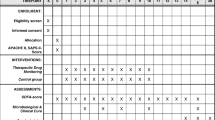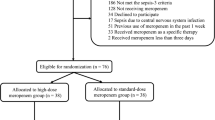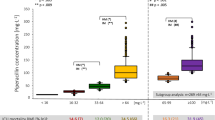Abstract
Background and Objectives
Morbidity and mortality from serious infections are common in intensive care units (ICUs). The appropriateness of the antibiotic treatment is essential to combat sepsis. We aimed to evaluate pharmacokinetic/pharmacodynamic target attainment of meropenem and piperacillin/tazobactam administered at standard total daily dose as continuous infusion in critically ill patients without renal dysfunction and to identify risk factors of non-pharmacokinetic/pharmacodynamic target attainment.
Results
We included 118 patients (149 concentrations), 47% had microorganism isolation. Minimum inhibitory concentration (MIC) [median (interquartile range, IQR) values in isolated pathogens were: meropenem: 0.05 (0.02–0.12) mg/l; piperacillin: 3 (1–4) mg/l]. Pharmacokinetic/pharmacodynamic target attainments (100%fCss≥1xMIC, 100%fCss≥4xMIC and 100%fCss ≥ 8xMIC, respectively) were: 100%, 96.15%, 96.15% (meropenem) and 95.56%, 91.11%, 62.22% (piperacillin) for actual MIC; 98.11%, 71.70%, 47.17% (meropenem, MIC 2 mg/l), 95.83%, 44.79%, 6.25% (piperacillin, MIC 8 mg/l), 83.33%, 6.25%, 1.04% (piperacillin, MIC 16 mg/l) for EUCAST breakpoint of Enterobacteriaceae spp. and Pseudomonas spp. Multivariable linear analysis identified creatinine clearance (CrCL) as a predictive factor of free antibiotic concentrations (fCss) of both therapies (meropenem [β = − 0.01 (95% CI − 0.02 to − 0.0; p = 0.043)] and piperacillin [β = − 0.01 (95% CI − 0.02 to 0.01, p < 0.001)]). Neurocritical status was associated with lower piperacillin fCss [β = − 0.36 (95% CI − 0.61 to − 0.11; p = 0.005)].
Conclusion
Standard total daily dose of meropenem allowed achieving pharmacokinetic/pharmacodynamic target attainments in ICU patients without renal dysfunction. Higher doses of piperacillin/tazobactam would be needed to cover microorganisms with MIC > 8 mg/l. CrCL was the most powerful factor predictive of fCss in both therapies.


Similar content being viewed by others
References
Roberts JA, Abdul-Aziz MH, Lipman J, Mouton JW, Vinks AA, Felton TW, et al. Individualised antibiotic dosing for patients who are critically ill: challenges and potential solutions. Lancet Infect Dis. 2014;14(6):498–509. https://doi.org/10.1016/S1473-3099(14)70036-2.
Vardakas KZ, Voulgaris GL, Maliaros A, Samonis G, Falagas ME. Prolonged versus short-term intravenous infusion of antipseudomonal β-lactams for patients with sepsis: a systematic review and meta-analysis of randomised trials. Lancet Infect Dis. 2018;18(1):108–20. https://doi.org/10.1016/S1473-3099(17)30615-1.
Gonçalves-Pereira J, Póvoa P. Antibiotics in critically ill patients: a systematic review of the pharmacokinetics of β-lactams. Crit Care. 2011;15(5):R206. https://doi.org/10.1186/cc10441.
Pea F, Viale P, Furlanut M. Antimicrobial therapy in critically ill patients a review of pathophysiological conditions responsible for altered disposition and pharmacokinetic variability. Clin Pharmacokinet. 2005;44(10):1009–34. https://doi.org/10.2165/00003088-200544100-00002.
De Waele JJ, Carrette S, Carlier M, Stove V, Boelens J, Claeys G, et al. Therapeutic drug monitoring-based dose optimisation of piperacillin and meropenem: a randomised controlled trial. Intensive Care Med. 2014;40(3):380–7. https://doi.org/10.1007/s00134-013-3187-2.
Turnidge JD. The pharmacodynamics of beta-lactams. Clin Infect Dis. 1998;27(1):10–22. https://doi.org/10.1086/514622.
Roberts JA, Kirkpatrick CMJ, Roberts MS, Dalley AJ, Lipman J. First-dose and steady-state population pharmacokinetics and pharmacodynamics of piperacillin by continuous or intermittent dosing in critically ill patients with sepsis. Int J Antimicrob Agents. 2010;35(2):156–63. https://doi.org/10.1016/j.ijantimicag.2009.10.008.
Chytra I, Stepan M, Benes J, Pelnar P, Zidkova A, Bergerova T, et al. Clinical and microbiological efficacy of continuous versus intermittent application of meropenem in critically ill patients: a randomized open-label controlled trial. Crit Care. 2012;16(3):R113. https://doi.org/10.1186/cc11405.
Guilhaumou R, Benaboud S, Bennis Y, Dahyot-Fizelier C, Dailly E, Gandia P, et al. Optimization of the treatment with beta-lactam antibiotics in critically ill patients—guidelines from the French Society of Pharmacology and Therapeutics (Société Française de Pharmacologie et Thérapeutique—SFPT) and the French Society of Anaesthesia and Intensive Care Medicine (Société Française d’Anesthésie et Réanimation—SFAR). Crit Care. 2019;23(1):104. https://doi.org/10.1186/s13054-019-2378-9.
Moriyama B, Henning SA, Neuhauser MM, Danner RL, Walsh TJ. Continuous-infusion β-lactam antibiotics during continuous venovenous hemofiltration for the treatment of resistant gram-negative bacteria. Ann Pharmacother. 2009;43:1324–37. https://doi.org/10.1345/aph.1L638.
Tam VH, Schilling AN, Neshat S, Poole K, Melnick DA, Coyle EA. Optimization of meropenem minimum concentration/MIC ratio to suppress in vitro resistance of Pseudomonas aeruginosa. Antimicrob Agents Chemother. 2005;49(12):4920–7. https://doi.org/10.1128/AAC.49.12.4920-4927.2005.
Dulhunty JM, Roberts JA, Davis JS, Webb SAR, Bellomo R, Gomersall C, et al. Continuous infusion of beta-Lactam antibiotics in severe sepsis: a multicenter double-blind, randomized controlled trial. Clin Infect Dis. 2013;56(2):236–44. https://doi.org/10.1093/cid/cis856.
Rafati MR, Rouini MR, Mojtahedzadeh M, Najafi A, Tavakoli H, Gholami K, et al. Clinical efficacy of continuous infusion of piperacillin compared with intermittent dosing in septic critically ill patients. Int J Antimicrob Agents. 2006;28(2):122–7. https://doi.org/10.1016/j.ijantimicag.2006.02.020.
Roberts JA, Kirkpatrick CMJ, Roberts MS, Robertson TA, Dalley AJ, Lipman J. Meropenem dosing in critically ill patients with sepsis and without renal dysfunction: intermittent bolus versus continuous administration? Monte Carlo dosing simulations and subcutaneous tissue distribution. J Antimicrob Chemother. 2009;64(1):142–50. https://doi.org/10.1093/jac/dkp139.
Abdul-Aziz MH, Sulaiman H, Mat-Nor M-B, Rai V, Wong KK, Hasan MS, et al. Beta-Lactam Infusion in Severe Sepsis (BLISS): a prospective, two-centre, open-labelled randomised controlled trial of continuous versus intermittent beta-lactam infusion in critically ill patients with severe sepsis. Intensive Care Med. 2016;42(10):1535–45. https://doi.org/10.1007/s00134-015-4188-0.
Taccone FS, Laupland KB, Montravers P. Continuous infusion of β-lactam antibiotics for all critically ill patients? Intensive Care Med. 2016;42(10):1604–6. https://doi.org/10.1007/s00134-016-4241-7.
European Medicines Agency (EMA). Meropenem Product Information. 2015. https://www.ema.europa.eu/en/medicines/human/referrals/meronem. Accessed 15 May 2015.
European Medicines Agency (EMA). Piperacillin/tazobactam Product Information. 2015. https://www.ema.europa.eu/en/medicines/human/referrals/tazocin. Accessed 15 May 2015.
Rhodes A, Evans LE, Alhazzani W, Levy MM, Antonelli M, Ferrer R, et al. Surviving sepsis campaign. Crit Care Med. 2017;45(3):486–552. https://doi.org/10.1097/CCM.0000000000002255.
IBM Watson Health. IBM Micromedex® web applications access. Greenwood Village, Colorado, USA. 1970. https://www.micromedexsolutions.com. Accessed 1 June 2015.
Rigo-Bonnin R, Ribera A, Arbiol-Roca A, Cobo-Sacristán S, Padullés A, Murillo O, et al. Development and validation of a measurement procedure based on ultra-high performance liquid chromatography-tandem mass spectrometry for simultaneous measurement of β-lactam antibiotic concentration in human plasma. Clin Chim Acta. 2017;468:215–24. https://doi.org/10.1016/j.cca.2017.03.009.
Ulldemolins M, Roberts JA, Rello J, Paterson DL, Lipman J. The effects of hypoalbuminaemia on optimizing antibacterial dosing in critically ill patients. Clin Pharmacokinet. 2011;50(2):99–110. https://doi.org/10.2165/11539220-000000000-00000.
Quinton MC, Bodeau S, Kontar L, Zerbib Y, Maizel J, Slama M, et al. Neurotoxic concentration of piperacillin during continuous infusion in critically ill patients. Antimicrob Agents Chemother. 2017;61(9):e00654-e717. https://doi.org/10.1128/AAC.00654-17.
Imani S, Buscher H, Marriott D, Gentili S, Sandaradura I. Too much of a good thing: a retrospective study of β-lactam concentration-toxicity relationships. J Antimicrob Chemother. 2017;72(10):2891–7. https://doi.org/10.1093/jac/dkx209.
Udy AA, Roberts JA, Boots RJ, Paterson DL, Lipman J. Augmented renal clearance: implications for antibacterial dosing in the critically ill. Clin Pharmacokinet. 2010;49(1):1–16. https://doi.org/10.2165/11318140-000000000-00000.
Dhillon S, Kostrzewski AJ. Basic pharmacokinetics. In: Clinical pharmacokinetics. London: Pharmaceutical Press; 2006. p. 1–44.
European Committee on Antimicrobial Susceptibility Testing. Breakpoint tables for interpretation of MICs and zone diameters, version 11.0, 2020. http://www.eucast.org/clinical_breakpoints. Accessed 24 Dec 2020.
Dhaese SAM, Thooft ADJ, Farkas A, Lipman J, Verstraete AG, Stove V, et al. Early target attainment of continuous infusion piperacillin/tazobactam and meropenem in critically ill patients: a prospective observational study. J Crit Care. 2019;52:75–9. https://doi.org/10.1016/j.jcrc.2019.04.013.
Aardema H, Nannan Panday P, Wessels M, van Hateren K, Dieperink W, Kosterink JGW, et al. Target attainment with continuous dosing of piperacillin/tazobactam in critical illness: a prospective observational study. Int J Antimicrob Agents. 2017;50(1):68–73. https://doi.org/10.1016/j.ijantimicag.2017.02.020.
Richter DC, Frey O, Röhr A, Roberts JA, Köberer A, Funchs T, et al. Therapeutic drug monitoring-guided continuous infusion of piperacillin/tazobactam significantly improves pharmacokinetic target attainment in critically ill patients : a retrospective analysis of four years of clinical experience. Infection. 2019;47:1001–11. https://doi.org/10.1007/s15010-019-01352-z.
Carlier M, Carrette S, Roberts JA, Stove V, Verstraete A, Hoste E, et al. Meropenem and piperacillin/tazobactam prescribing in critically ill patients: does augmented renal clearance affect pharmacokinetic/pharmacodynamic target attainment when extended infusions are used? Crit Care. 2013;17(3):R84. https://doi.org/10.1186/cc12705.
Conil JM, Georges B, Mimoz O, Dieye E, Ruiz S, Cougot P, et al. Influence of renal function on trough serum concentrations of piperacillin in intensive care unit patients. Intensive Care Med. 2006;32(12):2063–6. https://doi.org/10.1007/s00134-006-0421-1.
Udy AA, Varghese JM, Altukroni M, Briscoe S, McWhinney BC, Ungerer J, et al. Subtherapeutic initial b-lactam concentrations in select critically ill patients. Chest. 2012;142(1):30–9. https://doi.org/10.1378/chest.11-1671.
Udy AA, Lipman J, Jarrett P, Klein K, Wallis SC, Patel K, et al. Are standard doses of piperacillin sufficient for critically ill patients with augmented creatinine clearance? Crit Care. 2015;19(1):28. https://doi.org/10.1186/s13054-015-0750-y.
Carrié C, Legeron R, Petit L, Ollivier J, Cottenceau V, d’Houdain N, et al. Higher than standard dosing regimen are needed to achieve optimal antibiotic exposure in critically ill patients with augmented renal clearance receiving piperacillin-tazobactam administered by continuous infusion. J Crit Care. 2018;48:66–71. https://doi.org/10.1016/j.jcrc.2018.08.026.
Alobaid AS, Hites M, Lipman J, Taccone FS, Roberts JA. Effect of obesity on the pharmacokinetics of antimicrobials in critically ill patients: a structured review. Int J Antimicrob Agents. 2016;47(4):256–68. https://doi.org/10.1016/j.ijantimicag.2016.01.009.
Alobaid AS, Wallis SC, Jarrett P, Starr T, Stuart J, Lassig-Smith M, et al. Effect of obesity on the population pharmacokinetics of meropenem in critically ill patients. Antimicrob Agents Chemother. 2016;60(8):4577–84. https://doi.org/10.1128/AAC.00531-16.
Hites M, Taccone FS, Wolff F, Cotton F, Beumier M, De Bacher D, et al. Case-control study of drug monitoring of β-lactams in obese critically ill patients. Antimicrob Agents Chemother. 2013;57(2):708–15. https://doi.org/10.1128/AAC.01083-12.
Cheatham SC, Fleming MR, Healy DP, Chung EK, Shea KM, Humphrey ML, et al. Steady-state pharmacokinetics and pharmacodynamics of meropenem in morbidly obese patients hospitalized in an intensive care unit. J Clin Pharmacol. 2014;54(3):324–30. https://doi.org/10.1002/jcph.196.
Adnan S, Li JX, Wallis SC, Rudd M, Jarrett P, Paterson DL, et al. Pharmacokinetics of meropenem and piperacillin in critically ill patients with indwelling surgical drains. Int J Antimicrob Agents. 2013;42(1):90–3. https://doi.org/10.1016/j.ijantimicag.2013.02.023.
Fujii M, Karumai T, Yamamoto R, Kobayashi E, Ogawa K, Tounai M, et al. Pharmacokinetic and pharmacodynamic considerations in antimicrobial therapy for sepsis. Expert Opin Drug Metab Toxicol. 2020;16(5):415–30. https://doi.org/10.1080/17425255.2020.1750597.
Roberts JA, Lipman J. Pharmacokinetic issues for antibiotics in the critically ill patient. Crit Care Med. 2009;37(3):840–51. https://doi.org/10.1097/CCM.0b013e3181961bff.
Blot SI, Pea F, Lipman J. The effect of pathophysiology on pharmacokinetics in the critically ill patient: concepts appraised by the example of antimicrobial agents. Adv Drug Deliv Rev. 2014;77:3–11. https://doi.org/10.1016/j.addr.2014.07.006.
May CC, Arora S, Parli SE, Frase JF, Thompson M, Cook AM. Augmented renal clearance in patients with subarachnoid hemorrhage. Neurocrit Care. 2015;23(3):374–9. https://doi.org/10.1007/s12028-015-0127-8.
Udy AA, Jarrett P, Lassig-Smith M, Stuart J, Starr T, Dunlop R, et al. Augmented renal clearance in traumatic brain injury: a single-center observational study of atrial natriuretic peptide, cardiac output, and creatinine clearance. J Neurotrauma. 2017;34(1):137–44. https://doi.org/10.1089/neu.2015.4328.
Damen C, Dhaese S, Verstraete AG, Stove V, De Waele JJ. Subtherapeutic piperacillin concentrations in neurocritical patients. J Crit Care. 2019;54:48–51. https://doi.org/10.1016/j.jcrc.2019.07.007.
Ullah S, Beer R, Fuhr U, Taubert M, Zeitlinger M, Kratzer A, et al. Brain exposure to piperacillin in acute hemorrhagic stroke patients assessed by cerebral microdialysis and population pharmacokinetics. Neurocrit Care. 2020;33(3):740–8. https://doi.org/10.1007/s12028-020-00947-x.
Triginer C, Izquierdo I, Fernández R, Torrent J, Benito S, Net A, et al. Changes in gentamicin pharmacokinetic profiles induced by mechanical ventilation. Eur J Clin Pharmacol. 1991;40(3):297–302. https://doi.org/10.1007/BF00315213.
Cawley MJ. Mechanical ventilation: a tutorial for pharmacists. Pharmacotherapy. 2007;27(2):250–66. https://doi.org/10.1592/phco.27.2.250.
Van der Merwe FV, Wallis S, Udy A. Understanding the impact of critical illness on drug pharmacokinetics: scientifically robust study design. J Clin Toxicol. 2011;S4:002. https://doi.org/10.4172/2161-0495.S4-002.
Georges B, Conil JM, Seguin T, Ruiz S, Minville V, Cougot P, Decun JF, et al. Population pharmacokinetics of ceftazidime in intensive care unit patients: Influence of glomerular filtration rate, mechanical ventilation, and reason for admission. Antimicrob Agents Chemother. 2009;53(10):4483–9. https://doi.org/10.1128/AAC.00430-09.
Acknowledgements
We thank the joint dedication of staff members of the departments of intensive care, infectious disease, microbiology, biochemistry and nursing staff of the Hospital Universitari de Bellvitge. Without the teamwork, it would not have been possible to carry out this project.
Author information
Authors and Affiliations
Corresponding author
Ethics declarations
Funding
Part of this study has been financed thanks to the aid for research projects granted to us by the Sociedad Española de Farmacia Hospitalaria (Convocatoria de Ayudas a Proyectos de Investigación de la SEFH 2013/2014. EPA056/14 ATB-2014-01).
Conflict of Interest
The authors declare that they have no competing interests.
Ethical Approval
The study was approved by the local Ethics Committee (SFB-ATB-2014-01) and conducted following the Declaration of Helsinki.
Consent to Participate
Written informed consent was requested from the patient or the closest relative before inclusion.
Consent for Publication
Not applicable.
Availability of Data and Materials
Main data will be made available on request to the corresponding author.
Code Availability
Not applicable.
Author Contributions
Conception and design: EEP, VGS, SCS, ESP, KMS, JSR, XPF, RRB, FTQ, HCC, APZ. Data collection: EEP, VGS, KMS. Analysis and interpretation: EEP, HCC, APZ. Drafting the manuscript for important intellectual content: EEP, HCC, APZ. Revision and final approval: EEP, VGS, SCS, ESP, KMS, JSR, XPF, RRB, FTQ, JC, HCC, APZ.
Supplementary Information
Below is the link to the electronic supplementary material.
Rights and permissions
About this article
Cite this article
Esteve-Pitarch, E., Gumucio-Sanguino, V.D., Cobo-Sacristán, S. et al. Continuous Infusion of Piperacillin/Tazobactam and Meropenem in ICU Patients Without Renal Dysfunction: Are Patients at Risk of Underexposure?. Eur J Drug Metab Pharmacokinet 46, 527–538 (2021). https://doi.org/10.1007/s13318-021-00694-0
Accepted:
Published:
Issue Date:
DOI: https://doi.org/10.1007/s13318-021-00694-0




